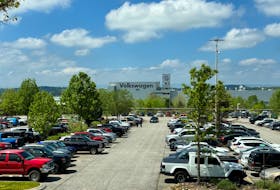ELMSDALE, N.S. — The weather is bitter cold, and the wind is howling.
Just down the road, the power is out. Forecasts warn that snowfall amounts of 20-30 centimetres are on the way.
But inside, the lights are on, the fridge is cold and the kids are continuing to play Fortnite on their PlayStation.
The microwave clock doesn’t even need to be reset.
A power outage is usually something Nova Scotia Power staff and executives don’t like to see at any time of the year, but Jill Searle, senior program manager with the utility, was rubbing her hands together with excitement to see how her latest pet project would turn out.
And it passed with flying colours.
“There’s not many people at Nova Scotia Power who would admit to hoping the power goes out, but with our little project team, we were kind of hoping to have an outage on this circuit so we could test it,” Searle said. “Unfortunately for customers, fortunately for us, that did happen.”
A powerful winter storm on Jan. 4, 2018 provided the outage she was waiting for, an extended one of approximately five hours, right around suppertime.
“Anecdotally, feedback from our customers said they cooked their supper, watched TV, went to bed around 11 that night and still had over 85 per cent left in their batteries,” she said. “The transfer from the power outage to the Powerwall is seamless — there’s no blip.”

The Intelligent Feeder Project, a partnership between the utility and Opus One Solutions, through a grant from Sustainable Development Technology Canada, is testing the waters on incorporating Tesla batteries at the micro and macro level in Elmsdale.
Ten homes in Elmsdale, which are part of a microgrid, have Tesla Powerwalls installed — large, white panel batteries, with the Silicon Valley stylized logo emblazoned on the front.
In tandem with that, wind power that’s being generated at the nearby Hardwood Lands is being stored in a Tesla Powerpack at the Elmsdale substation.
A row of lithium-ion batteries, approximately seven feet high and 30 feet long, stretches just beyond the series of wires and cables that Nova Scotians are used to seeing at the NS Power facilities.
This technology allows the energy generated by the turbines to be stored in the batteries and dispatched when it’s needed.
Sensors along the grid are monitoring local system activity and being fed back to Nova Scotia Power’s control centre for analysis.
Huge potential
Searle said the potential for systems like this is huge.
“We wanted to see if we could use batteries, not just in customers’ homes, but also to see if they could provide reliability with wind integration for a whole distribution circuit.”
The whole circuit at the substation encompasses 1,000 customers, with 200 supported by the Tesla batteries.
“The price of energy storage is still challenging, which is another reason why we’re approaching this as a pilot project,” she said. “We weren’t ready to invest on a large scale at this point.”
Searle said the price of large-scale battery storage is “coming down all the time,” and the economics of this sort of project is definitely a major component of the pilot.
“How big should a battery be? How much is it going to cost for the value you’re getting out of it? We’re definitely looking at all of that as part of our analysis,” she said.
There are still aspects that are being tested, like how they’re holding up through a Nova Scotia winter, for example.
The pilot is scheduled to run until the end of 2019.
Opus One, a company based in Ontario that develops electrical grid software, partnered with Nova Scotia Power on this project, applying through the Sustainable Technology Canada Clean Energy Fund, a federal government program, which covered one-third of the costs.
At the end of the pilot, the batteries and infrastructure will remain in use, Searle said.
“The response from customers so far who have the Powerwalls in their homes has been very positive,” she said. “They’ve been quite thrilled with how they’ve performed.”
The Powerwalls typically don’t cover an entire home. A sub-panel is installed and customers pick which appliances they want to be covered by the battery.
Anyone can purchase and hire a certified electrician to install one or more of the Tesla Powerwalls themselves.
“The battery backup, other than providing reliability in the event of an outage, can do things like, if you have solar panels on your home, they can charge the batteries and offset the use of the grid,” she said. “If you have time-of-use rates, you can charge the batteries during off-peak time and deploy them at peak time, which helps to price arbitrage your rates.”
There are currently over 600 megawatts of power generated by wind turbines in the province, accounting for approximately 19 per cent of Nova Scotia’s electricity.
“This project, for us and for me personally, has been fantastic,” she said.
“We’ve had a lot of industry interest in this because a lot of jurisdictions are talking about storage as a utility asset, but not many are actually doing it,” she continued.
“We’re one of the few who are. We are leading edge on some of this work, which is really exciting.”
In-home battery
Mac and Anne Noble, who live in Elmsdale, are one of the 10 households in the community who are part of the project. They have a Tesla Powerwall battery installed in their home.
During a recent power outage their heating system, refrigerator, lights, and other appliances continued to hum with electricity while their neighbours were in the dark.

“Our furnace is hot water, that’s on the (Powerwall) circuit; all of our lights in this part of the house, our freezer, our fridge,” Mac Noble said. “But the furnace was the key for us because it’s our heat and hot water.”
“When the power goes out, it’s completely instantaneous,” he said. “The (desktop) computer I have over there, it didn’t even flicker when it went out.”
Noble said he and his wife, who are both retired, were a bit skittish about participating at first but decided to give it a try after some convincing.
“Our neighbour next door, their young fella was in Grade 12 and learning about renewable energy and he encouraged us to get with the program,” Noble said with a laugh. “So we applied for it. The engineers who installed it were very down to earth and made us very comfortable with the process.”
The Powerwall battery and installation were worth approximately $15,000, Noble said, which Nova Scotia Power covered as part of this project.
The Nobles are able to keep the battery for free for the first five years, with the option to keep it afterwards, including an additional five-year sponsorship deal with the utility.
When asked if they’ll keep the battery once the pilot is over, Noble said they likely will, as it adds value to the home once they choose to sell.
“It’s definitely been an eye-opener from an educational standpoint for us,” he said.
Research opportunity
Wayne Groszko is an applied energy research scientist with the NSCC and has also been involved with studies surrounding energy storage technologies, both for power and heat.
He said he’s happy to see the province’s main power utility dipping their toes in energy storage research like this.
“When you look at the electrical grid in Nova Scotia, we are increasingly seeing a desire from both individual citizens and the government to have more of the electricity supplied come from renewables,” Groszko said. “The main renewable sources we have available…wind and solar in particular, vary a lot in their output over time.”
“If you have a way to store that power, that’s a big advantage,” he said. “It allows you to use it when the wind is not blowing and the sun’s not shining.”

Groszko said he was happy to see that Nova Scotia Power is taking a look at the technology at two different scales, at the individual home level and from a substation.
“The larger Powerpack is interesting, equivalent to quite a number of homes, enough to run, at least partially, that neighbourhood that’s connected to that substation in the case of a power outage. It was able to continue operating through a major power outage, which was really quite neat,” he said.
“It’s also a way of smoothing out the contribution of wind power on that grid by storing it,” he said. “From a technical perspective, I think this is a good thing to be testing out.”
Although the pilot project emphasizes batteries, Groszko said there are other ways utilities can store energy that could also be looked at in the future.
“Sharing and storing electrical power will be essential when bringing on things like more wind energy,” he said. “Bringing on more turbines is good, but you’ll eventually get to a point when you have surplus wind power on the grid, and other times when it’s not windy and there is no power available.”
Potential solutions to that include beefing up the transmission lines to other jurisdictions to trade power when needed, allowing the province to buy power when needed or sell it when there’s a surplus.
Another solution is storing the energy locally, either through batteries or other methods like pumped hydro storage.
“What will probably turn out to be best is an all-of-the-above approach,” he said. “We have a better connection with Newfoundland through the Maritime Link subsea cable, which opens up trading wind and hydropower with them. And we could also bring more batteries online as well.”








